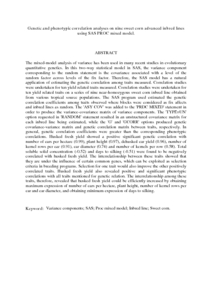Citation
Kashiani, Pedram and Saleh, Ghizan
(2009)
Genetic and phenotypic correlation analyses on nine sweet corn advanced inbred lines using SAS PROC mixed model.
International Society for Southeast Asian Agricultural Sciences, 15 (1).
237- .
ISSN 0859-3132
Abstract
The mixed-model analysis of variance has been used in many recent studies in evolutionary quantitative genetics. In this two-way statistical model in SAS, the variance component corresponding to the random statement is the covariance associated with a level of the random factor across levels of the fix factor. Therefore, the SAS model has a natural application of estimating the genetic correlation among traits measured. Correlation studies were undertaken for ten yield related traits measured. Correlation studies were undertaken for ten yield related traits on a series of nine near-homozygous sweet corn inbred line obtained from various tropical source populations. The SAS program used estimated the genetic correlation coefficients among traits observed where blocks were considered as fix affects and inbred lines as random. The 'ASY COV' was added to the 'PRDC MIXED' statement in order to produce the variance-covariance matrix of variance components. The 'TYPE=UN' option requested in 'RANDOM' statement resulted in an unstructured covariance matrix for each inbred line being estimated, while the 'G' and 'GCORR' options produced genetic covariance-variance matrix and genetic correlation matrix between traits, respectively. In general, genetic correlation coefficients were greater than the corresponding phenotypic correlations. Husked fresh yield showed a positive significant genetic correlation with number of ears per hectare (0.99), plant height (0.97), dehusked ear yield (0.96), number of kernel rows per ear (0.91), ear diameter (0.74) and number of kernels per row (0.58). Total soluble solid concentration (-0.52) and days to silking (-0.51) were found to be negatively correlated with husked fresh yield. The interrelationship between these traits showed that they are under the influence of certain common genes, which can be exploited as selection criteria in breeding programs. Selection for one trait would also improve the other positively correlated traits. Husked fresh yield also revealed positive and significant phenotypic correlations with all traits mentioned for genetic relation. The interrelationship among these traits, therefore, revealed that husked fresh yield could be efficiently increased by obtaining maximum expression of number of ears per hectare, plant height, number of kernel rows per ear and ear diameter, and obtaining minimum expression of days to silking.
Download File
![[img]](http://psasir.upm.edu.my/14874/1.hassmallThumbnailVersion/Genetic%20and%20phenotypic%20correlation%20analyses%20on%20nine%20sweet%20corn%20advanced%20inbred%20lines%20using%20SAS%20PROC%20mixed%20model.pdf)  Preview |
|
PDF (Abstract)
Genetic and phenotypic correlation analyses on nine sweet corn advanced inbred lines using SAS PROC mixed model.pdf
Download (85kB)
| Preview
|
|
Additional Metadata
Actions (login required)
 |
View Item |

